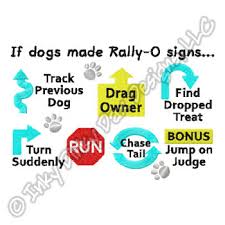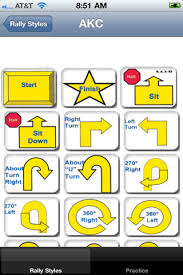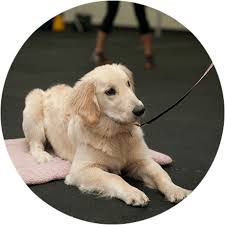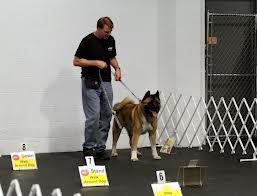Rally Obedience has been a titling event through the Association of Pet Dog Trainers (APDT) since September 2001. The American Kennel Club (AKC) addes Rally to it’s roster of dog sports on January 1, 2005. Here’s an amazing statistic: In the AKC alone , in the first 8 months of Rally being a titling event , 8,912 dogs were entered in 658 Rally trials. Compare that to the first year agility was accepted by the AKC: only 23 trials and 2000 entries. Pretty remarkable!

I love Rally. It is a combination of obedience and agility. It is not as formal as competitive obedience and alot more laid back and fun. The behaviors learned are wonderful for living in the real world, with real dogs and real life scenarios, and can be instrumental in getting you and your dog out of real danger. The come front, about turn, about U turn, moving side step right, moving down, fast forward from a sit and attention heeling can become part of your regular training, whether you are an instructor or dog owner.
Competing in Rally enhances the human/dog bond like no other sport. Unlike competitive obedience, you are encouraged to talk to your dog throughout the course. In agility you are moving so fast that you haven’t much breath left for interacting and talking to him.
Learning is often more fun with a specific purpose in mind, and Rally is a worthwhile goal. Aim for that goal, but plan on a pleasant surprise. These exercises will not simply be valuable to you in the show ring, They will greatly enhance your day to day routine with your dog.
Rally Obedience was initially developed by Charles Kramer in 2002. Charles Kramer was also the first innovator in the American agility program back in 1984. Over the years, Kramer had watched interest in competition obedience decline. To attract new people to the sport of dogs, he came up with the idea for a sport with a “softer” climate than traditional competition obedience, one that more enhanced the human/dog bond. And so Rally was born.
When competing in Rally, you essentially follow a course of signs and perform the behaviors listed on each sign. The judge does not follow you closely, just near enough to score you. You are on your own once you tell the judge you are “ready”! You complete the course at your speed and can talk to your dog the entire time if you wish.


Reasons to Compete in Rally
Rally is all about having fun and interacting with your dog while competing for titles. If you enjoy training your dog and want to take that training past the basics or if you are wondering what a good next step would be after the Canine Good Citizen (CGC) title, Rally is a wonderful sport to train for. Although you don’t have to have your CGC to compete, it is important that your dog knows and is proficient at loose leash walking ,the heel command, and ignoring other dogs so he is responsive to basic cues such as sit, come, down and stay. Even if your dog is just beginning to learn these things, you can start Rally training.
Trialing can be scary for the new, and not so new, competitor. Rally is a fantastic way for both you and your dog to get used to the show scene and to take your training to new heights of proficiency. Once you have completed your Rally titles, it is quite easy to segue into any other dog sport you may be interested in pursuing-be it competition obedience, agility, lure coursing, fly-ball or nose work to name a few.

The AKC and other venues are cracking down on unruly dogs that compete in agility and have been issuing non qualifying scores to dog’s that are not under their handler’s control. So while you don’t need agility training to do Rally, you do need some of the basic training used in Rally to do agility.
How Rally Differs from Competition Obedience

In competition obedience you are allowed to talk to your dog only between exercises. The patterns followed are very similar, if not identical, no matter what judge you show under. The judge follows at a very close distance and calls out instructions such as “right turn”, “left turn”, “about turn”, and “halt”. In AKC competition obedience (Novice) the heeling pattern is done on leash, then again off leash with a stand for exam in between (with direct contact between the judge and your dog). Once this is completed, there is an off leash recall. At the end are group stays, with a one minute sit/stay in a group of approximately 11 other dogs and then a three minute down/stay in that same group of dogs.
Training with Positive Methods
One of the major objectives of the sport of Rally is that the dog and handler team are just that, a team working together in a happy and joyful manner, showing off the bond and training between them. That lighthearted relationship can only be present in the ring when it exists at home. Training Rally behaviors to precision using positive reinforcement will not only result in a better relationship with your dog and a dog that loves to compete, but also will yield you the same high scores as traditional training methods.
It is very important to train your dog so that he can experience success without the fear of making a mistake. This is achieved by breaking down the behavior into tiny pieces known as approximations. The smaller the approximation , the easier it is to teach the “big” behavior. It is crucial to know how to break each behavior down into steps that your dog finds manageable and understandable, so he can figure out just what he is being taught. Every time your dog is successful at learning one of these small steps , you keep his interest, and, more importantly, build his confidence.
You want your dog to be as successful as he can be, and your training should be geared to that end goal. However, although you will always set the dog up to be right, there are times when he will give you a wrong response. In these cases, you should not hurry to “fix him”, but instead, should give him some time to think. Only by sampling other behaviors can your dog find out exactly what gets him reinforcement. In positive training, failure is not necessarily bad, rather it teaches the dog what works and what doesn’t.
You want your dog to experience as much success as possible-too much failure can create an aggressive, frustrated or quitter dog. If your dog is regularly failing, then training has probably been pushed too far, too fast. He may be tired or not in the mood that day or you may be drilling him too much or not making the steps small enough. You also may have changed your signals without meaning to, thus causing some confusion. Training is an art, and you will need to develop a feel for when you need to make a step easier for your dog to understand and when you should allow him to fail, thereby giving him the chance to think the problem through.

Training for any sport should be teamwork and fun for both of you. The joy you bring to training will shine through in the ring.
Rally Levels
There are two venues in Rally. The APDT and AKC
AKC Rally has three levels:
Rally Novice performed on leash-Designation RN
Rally Advanced performed off leash-Designation RA
Rally Excellent performed off leash-Designation RE
In order to receive each designation you will need 3 qualifying scores of 70 % or higher.
AKC also offers a Rally Advanced and Rally Excellent title-Designation RAE. To receive an RAE you need 10 double Q’s. Two qualifying runs -1 Rally Advanced Q and 1 Rally Excellent Q in the same trial.
Pamela Dennison
